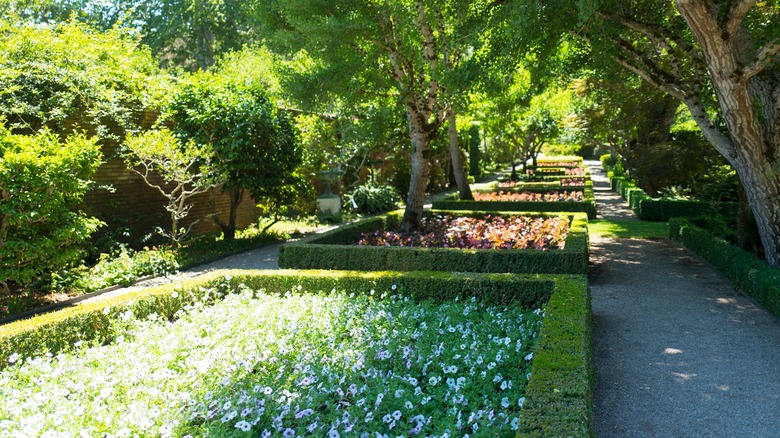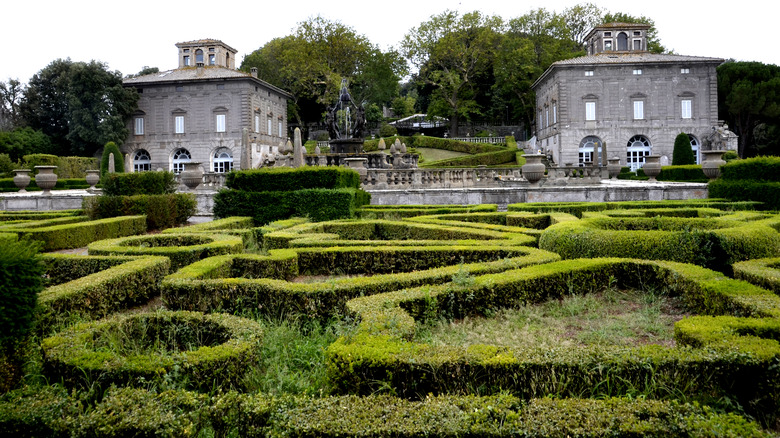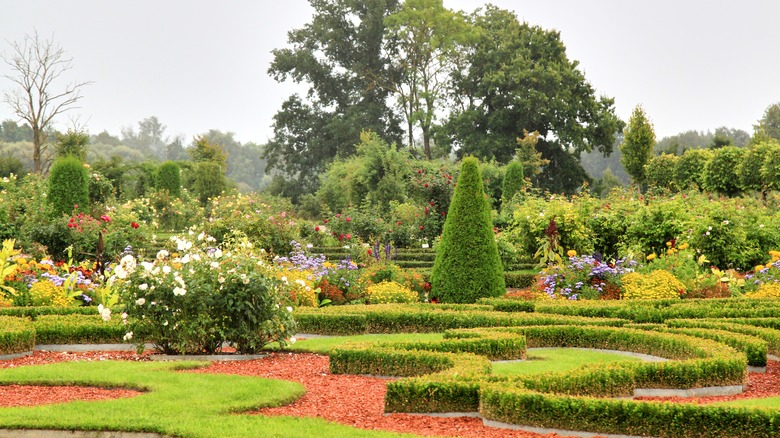What Is A Parterre Garden And How To Create One In Your Yard
For centuries, a well-kept, orderly parterre garden has been the hallmark of wealthy estates and countryside chateaus. Designed to be appreciated mostly from above, like a second-story window or a grand sweeping terrace, these intricately designed gardens typically consist of symmetrical and decoratively laid-out planting beds featuring a variety of flowers and greenery. The beds are usually outlined by more uniformly sized box hedges or other elements that create and contain the existing lines and shapes.
The effect of, and early inspiration for, such gardens was an embroidered look, with grass, gravel, or stone pathways winding through the beds and other elements like statues and fountains often at the center. While it's a formal look to be sure, there are some great ideas and inspiration you can take from parterre gardens for your own backyard, no matter its size or location. They can particularly be great for small yards that need the structure that a parterre arrangement can provide. The design is also great for creating a smaller, more intimate garden space in a large yard.
How did parterre gardens originate?
Parterre gardens have their roots in 16th century France, when garden designer Claude Mollet laid out two of the first examples at Saint-Germain-en-Laye and Fontainebleau. Interest in the gardens spread quickly among well-heeled noblemen across Europe.
Mollet was inspired by carefully planted knot gardens, which often created a pattern of walkways, herbs, and other plants designed to be frequented by strolling monks, nuns, and other clergy. In England, the style became known as "parterre de broderie," reflecting the impact of embroidery designs on the gardens. "Parterre" is French for "on the ground."
The style persisted and evolved over the next few centuries, often shifting according to fashion, with straighter, more geometric configurations often giving way to curved and ornately carved curlicue designs at various points. The style enjoyed a renewed interest among the middle class in the Victorian age, with rich, colorful gardens outlined by straight edges and carefully-laid paths. While the symmetry and patterned effect remained the same, the kinds of plantings and shapes changed over the years.
How to create a parterre garden
Looking to add some parterre garden influence to your outdoor space? To create the outlines for the beds, evergreens like boxwood are a popular choice, and can easily be scaled in height according to the size of your yard, the style of your home, and the height of your other plantings and flowers.
According to garden designer Richard Miers in Homes and Gardens, "The human eye loves repetition and this is what keeps the parterre style so timeless and a feature of gardens the world over." Within the confines of the pattern, Miers urges gardeners to be more creative, exploring various plantings and edging options to create the same effect. You can also think vertically, incorporating higher elements like topiaries or fruit trees within the confines of your edgings. Paths can be grass, gravel, or paver stones.
While many suggest that parterre gardens may require a bit more upkeep than other varieties of gardens, you will mostly want to keep the pathways clear and the edging hedges orderly, while allowing the beds themselves a bit of leeway. While many homeowners plant yearly ornamental flowers, others will foster perennials, wildflowers, herbs, grasses, and flowering bushes in their confines.


